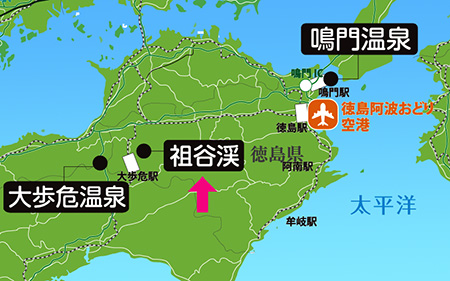


「祖谷のかずら橋 ゆらゆら揺れど、
主(ぬし)と手を引きゃ コワくない」
という「民謡」があるそうなのですが、手を引き合うほど若くないので(笑)
実際に体験するとなかなか大変。
これは屋島の「四国村」に再現された「かずら橋」。
実物は徳島県祖谷という四国の秘境として知られる険しい山地にある。
深い谷間を流れる急流が、隣接する地域同士の交通を分断させていた。
いつの頃からか村人が山に自生の「白口かずら」というつる状植物を編み上げ
この吊り橋を作ることに成功し、対岸同士の往来が容易になった。
自然素材を活かした造作なので3年ごとに掛け替えられるのだという。
この再現に当たっては祖谷地方の技術保持者を招聘し材料も
現地の白口かずらを使って完成させたのだという。
渡ってみると、揺れることはそう大きな問題ではないが、足下の丸木の間隔が
そこそこ空隙があるので一歩一歩確認が必要でした。オモシロかった。
でもまぁ後ろでカミさんはときどき悲鳴を上げていた(笑)。

この祖谷地域というのは平家の落人伝承で知られた山里。
〜徳島県三好市祖谷は幼い安徳天皇と平教経(変名して国盛)一行がこの地に逃れ
平家再興の望みをつないだという『もうひとつの平家物語』が語り伝えられる。
1184年の壇ノ浦の戦いに敗れ、平氏一門の武将たちは覚悟を決め、海に入水し、
幼い安徳天皇も祖母である二位尼に抱かれて、西の海に身を投げたといいます。
また祖谷平家伝説の主人公、平教経(以下、平国盛)も源氏の武者二人を道連れに
海に沈んだといわれているが、安徳天皇も平国盛も実は影武者だった・・・。
「屋島の戦い」で敗れた後、平国盛(教経)一行は幼い安徳天皇をお守りしながら、
この祖谷の地にやって来て山深い地で平氏再興の望みをつないでいたという。〜
実際にこの地域にはこの平家落人伝承にまつわる地名が数多く残っている。
全国各地にこうした伝承はあるのでなにごとかの実態はあったのでしょう。
このかずら橋自体も平家のひとびとが掛けた伝承があるという。
もし追っ手が迫ったときにこの橋を切り落とせば追撃を遮断できる。
そういった軍事技術の痕跡がみえてもくる。
しかし鎌倉期の公共事業の一種として考えるとこれも興味深い。
現代でも秘境と言われるような山深い地域で、このような公共利用に供する橋が
ずっと技術伝承されてきた事実は当時の最先端技術がここに確かに存在したことを
雄弁に物語っているのではないか。
またそれが民謡にまで歌われてきたというのはもっと興味を惹く。
民俗・民族としての深い愛着をそこに感じさせられる。
自分でも体験することでそうした印象に陰影が強くなるとも思う。
四国に花開いた人間居住空間の奥行きが伝わってきます。
English version⬇
[Iyanokazura Bridge, the land of Heike folklore, Shikoku living space exploration-2]
"Iyanokazura Bridge, swaying, but
If you withdraw from the Lord (Nushi), he won't be afraid. "
There seems to be a "folk song", but it's not young enough to hold hands (laughs).
It is quite difficult to actually experience it.
This is the "Kazura Bridge" reproduced in "Shikoku Village" on Yashima.
The real thing is in the steep mountainous area of Iya, Tokushima Prefecture, which is known as the unexplored region of Shikoku.
Rapids flowing through deep valleys disrupted traffic between adjacent areas.
From some time ago, villagers knit a vine-shaped plant called "Shiraguchi Kazura" that grows naturally in the mountains.
We succeeded in making this suspension bridge, and it became easier to come and go between the opposite banks.
It is said that it is a structure that makes use of natural materials, so it can be replaced every three years.
In recreating this, we invited technology holders from the Iya region to use materials.
It is said that it was completed using the local Shiraguchi Kazura.
When I crossed it, shaking was not a big problem, but the distance between the logs under my feet was
Since there are some gaps, it was necessary to check step by step. It was funny.
But behind me, Kami was screaming from time to time (laughs).
This Iya area is a mountain village known for the folklore of Heike's deceased people.
~ In Iya, Miyoshi City, Tokushima Prefecture, a young Emperor Antoku and Taira no Noritsune (renamed Kunimori) fled to this area.
"Another Heike Monogatari" that connects the hopes of the Heike revival is told.
After losing the Battle of Dannoura in 1184, the Taira clan warlords decided to enter the sea and entered the sea.
It is said that the young Emperor Antoku was also embraced by his grandmother, the second-ranked nun, and threw himself into the west sea.
In addition, Taira no Noritsune (hereinafter referred to as Taira no Noritsune), the main character of the legend of the Iya Heike, also takes two warriors of Genji with him.
It is said that it sank in the sea, but both Emperor Antoku and Taira Kunimori were actually shadow warriors ...
After being defeated in the "Battle of Yashima", Taira no Noritsune and his group protected the young Emperor Antoku while protecting the young Emperor Antoku.
It is said that he came to this land of Iya and connected his hopes for the revival of the Taira clan in the deep mountains. ~
In fact, many place names related to this Heike folklore remain in this area.
Since there are such folklore all over the country, there must have been something in reality.
It is said that this Kazura Bridge itself has a tradition of being hung by the Heike people.
If the chase is approaching, you can cut off this bridge to block the chase.
Traces of such military technology can be seen.
However, this is also interesting when considered as a type of public works project during the Kamakura period.
In a mountainous area that is said to be an unexplored region even today, there are bridges for public use like this.
The fact that technology has been handed down for a long time is that the state-of-the-art technology at that time certainly existed here.
Isn't it eloquently speaking?
It is even more interesting that it has been sung in folk songs.
You can feel the deep attachment as a folk and ethnic group there.
I think that by experiencing it myself, the shadows will become stronger in that impression.
You can feel the depth of the human living space that has blossomed in Shikoku.



















